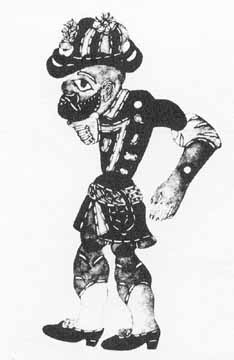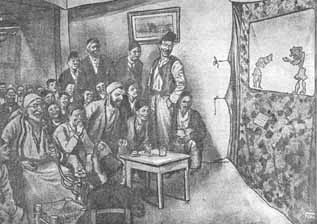|
|
Hacivat and
Karagöz are traditional Turkish puppets that wowed Ottoman audiences with
their audacious political banter; during the old days, this popular form of
public entertainment (usually) permitted uncensored criticism of the Ottoman
regime(s) by the commoners. They are also usually credited for having invented
Turkish Tongue Twisters.
|
|
|
| "Favorite
Diversion" |
For centuries throughout the Near and Middle East,
indeed from the Eastern Mediterranean to the Orient, one of the most popular
entertainments was shadow theater. Brightly colored puppets were the performers in this
lively theatrical art form which is now almost lost. In many ways a distinctive expression
of Islamic culture, shadow theater took various forms as it developed in different
countries. One of the most outstanding of these forms is Karagöz, the shadow theater of
Turkey.
 |
|
Mr. Karagoz
|
During Ramadan, Karagöz was
performed in town and village each evening as part of the traditional respite after a day
of fasting. Yet Ramadan was not the only occasion ‘for the merriment of Karagöz, nor
were the crowds in local coffee houses and public squares the only enthusiastic audiences.
In the homes of the wealthy, in the palace of the Sultan, at wedding feasts, circumcision
ceremonies and other joyful events, Karagöz was the favorite diversion. It peaked in the
mid-seventeenth century in the Ottoman Empire, but experienced periods of censorship and
repression because of its political satire and often salacious content. It declined toward
the end of the last century and the beginning of the present one, but comes to life today
as part of the revival of traditional Turkish Karagöz takes its name from one of the two
characters who feature in every performance. The other is Hacivat, with whom Karagöz
engages in lively banter. Their exchange includes verbal somersaults, absurd responses to
absurd rhetoric, comic and often coarse gestures, violent physical and verbal abuse,
biting satire against social and political conditions, and for those who have ears to
hear, deep mystical reflections upon truth.
Karagöz is easily identified by his large,
elaborate headgear, slightly turned-up nose, short, rounded beard, and enlarged moveable
forearm. He is crude, humorous, cross, disarmingly witty and naive by turn, and given to
misinterpretation of Hacivat’s pompous utterances. He is the illiterate teacher who
teaches from the heart, and he is often nearer to the homely truth than is his verbose
companion.
Hacivat wears a pointed hat and pointed beard. His
tunic has turned-back sleeves and from his waist hangs a tobacco pouch. Though Hacivat is
by no means a sophisticate, he sometimes tries to imitate the speech of the well-born and
the educated, seeking a willing ear for his philosophical, political and social
commentary. His clumsy and hilarious attempts at urbanity are satiric barbs aimed at the
pretentious and self-important.
 |
|
Turks of
the Ottoman Empire enjoying Hacivat and Karagoz.
(Illustration by Turkish artist Münif Fehim, 1950 or earlier.)
|
|
In addition to these two principals, a variety
of stock characters populate Karagöz. Each one is distinguished by a standard mode
of dress, speech and behavior.
The Karagöz puppet makes no pretense of
reality. It is a two-dimensional, ten or twelve inch figure of thinly stretched
leather, usually camel hide, roughly but skillfully stitched together with heavy,
visible gut. It is colored with bright vegetable dyes and baked in the sun to dry.
Then, to further destroy any semblance of real man, a prominent hole or two is made
in the figure to accommodate the sticks of the puppeteer. These two are carefully
reinforced with supporting hide and gut stitching.
The puppet master, or hayali, works behind a
small white screen made of tightly stretched linen, or sometimes only of greased
paper. It is framed by a curtain of bright carpets hung to conceal backstage and to
prevent light spill. His props are few: a small table to hold his figures: the
sticks—about fifteen inches long—with which he manipulates them; and two lights
positioned to the left and right between the puppeteer and the screen.
The hayali must know the scenario of the play
by heart. He must also improvise dialogue as the climate and taste of his audience
warrant; voice every role of the play:male and female, young and old, native and
foreigner; and express all the emotions of the characters. He must sing a variety of
songs, recite poetry, speak in different accents and spar verbally with himself. All
the while, he is jerking, sliding, and collapsing the figures pressed close against
the screen so that the illusion of continuous smooth action and believable speech or
song is all that filters through to the eyes and ears of his audience.
Though Karagöz, as a shadow theater is a
medium of comic entertainment it presents the richness of the Turkish culture. It
carries this tradition of folk entertainment from generation to generation as a part
of the Turkish life.
In September of last year, The Turkish-American Cultural Society of New England
represented Turkey at “Boston Jubilee 350.” A high point in the Turkish
presentation, which included displays of Turkish rugs and Turkish food, was the
presentation of a 103-piece KARAGOZ-HACIVAT sent to the Assistant Mayor of Boston as
a gift from Turkey.
This article on Karagöz is reprinted from the
Society’s bulletin.
Reprinted from Turkish-American
Cultural Society of New England
Newsletter No. 2 October 1980.
From ATA-USA, Jan-Feb. 1981
|
| "The
Magic of Traditional Greek Shadow Theatre" |
The Athens News Agency originally offered the following article on
the Greek version of "Karagoz," at photius.com/thus/karagiozis.html;
wow, they actually give credit to the form's Turkish origins. Ahhh... it's heartwarming
when our Orthodox friends stress the things that bind us, instead of the things that make
them so full of hatred.
|
|